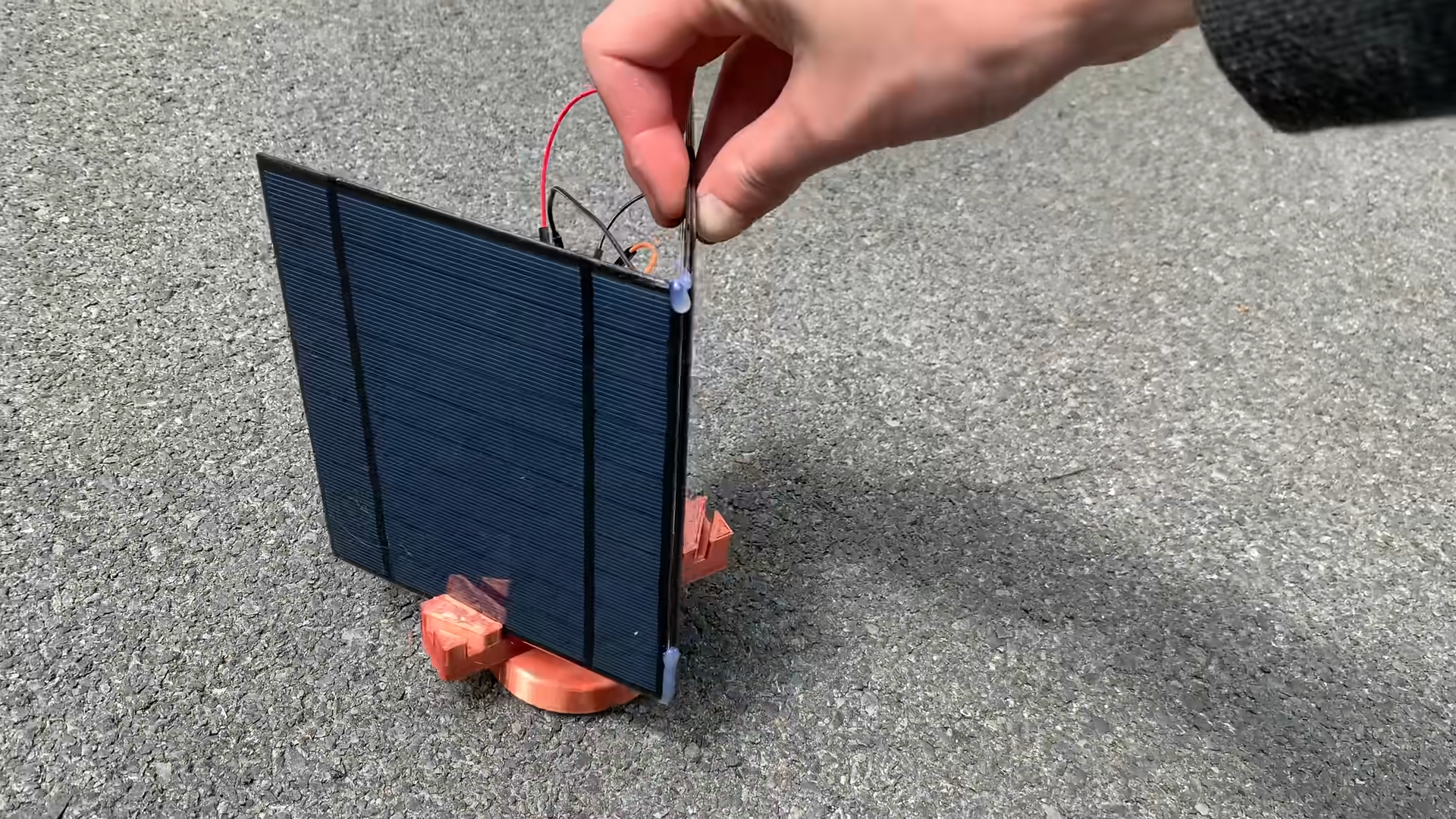Sidebar
SolarDIY
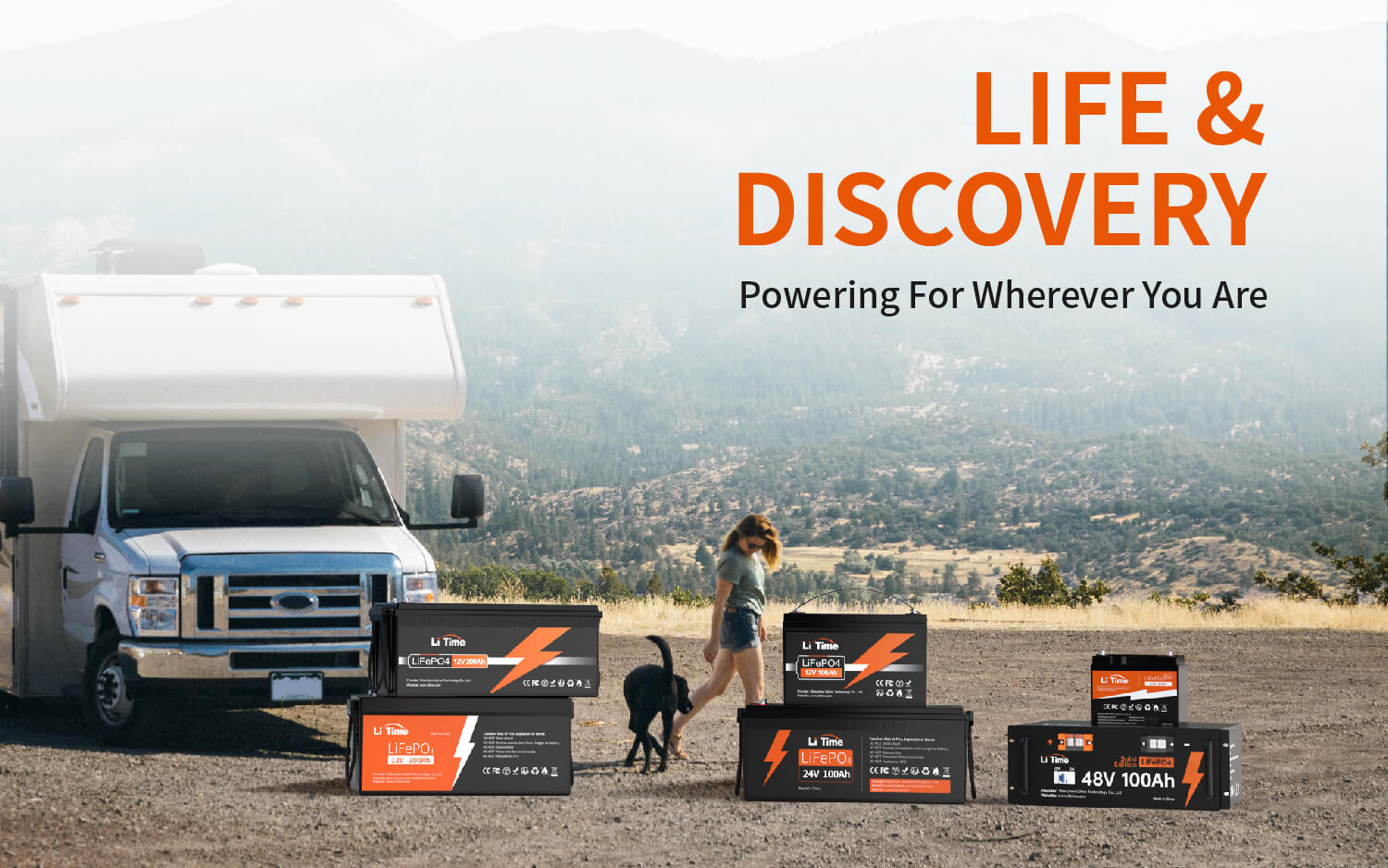 litime.com
litime.com
If this type of post isn't allowed, I can take it down. I am not affiliated with LiTime but I like their batteries since seeing Will Prowse's teardowns of them. They have some smaller battery options for DIY projects.

cross-posted from: https://natur.23.nu/post/12050 I wanted to park my bikes - or depending on the Season - my Renault Twizy somewhat protected and easy accessible. After adjusting the yard fence to form a pocket I put a frame aluminium profiles on top. On top of that is a second frame which is angled at 10 degrees and on that are the solar panels. 10 degrees seem to be a viable compromise between self cleaning, sun capture, construction height and openings to the elements on the side. 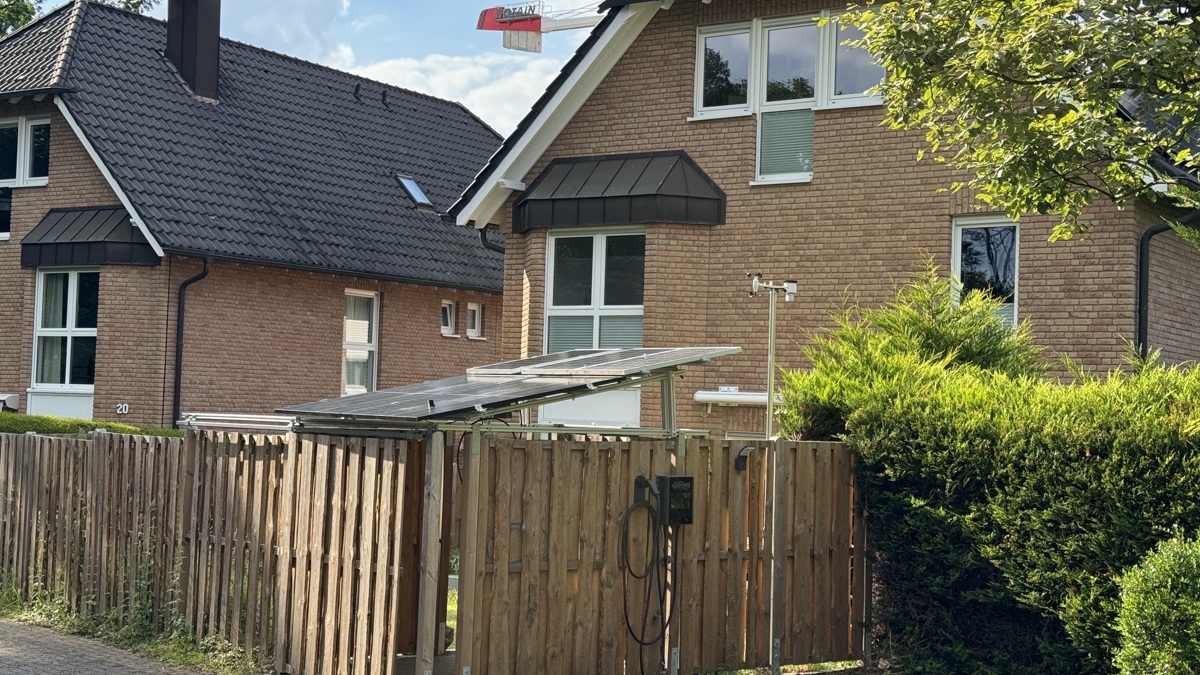 It was much more challenging than i thought to find solar modules with a form factor fitting the shed. 4 Standard modules where far to big. So I choose two modern 410 Wp modules and 3 130 Wp “camping” modules. I got two 600 W dyne (“Bosswerk”) Micro-inverters cheap, because everybody want’s 800 W now and they have a regulatory issue with a missing relay. 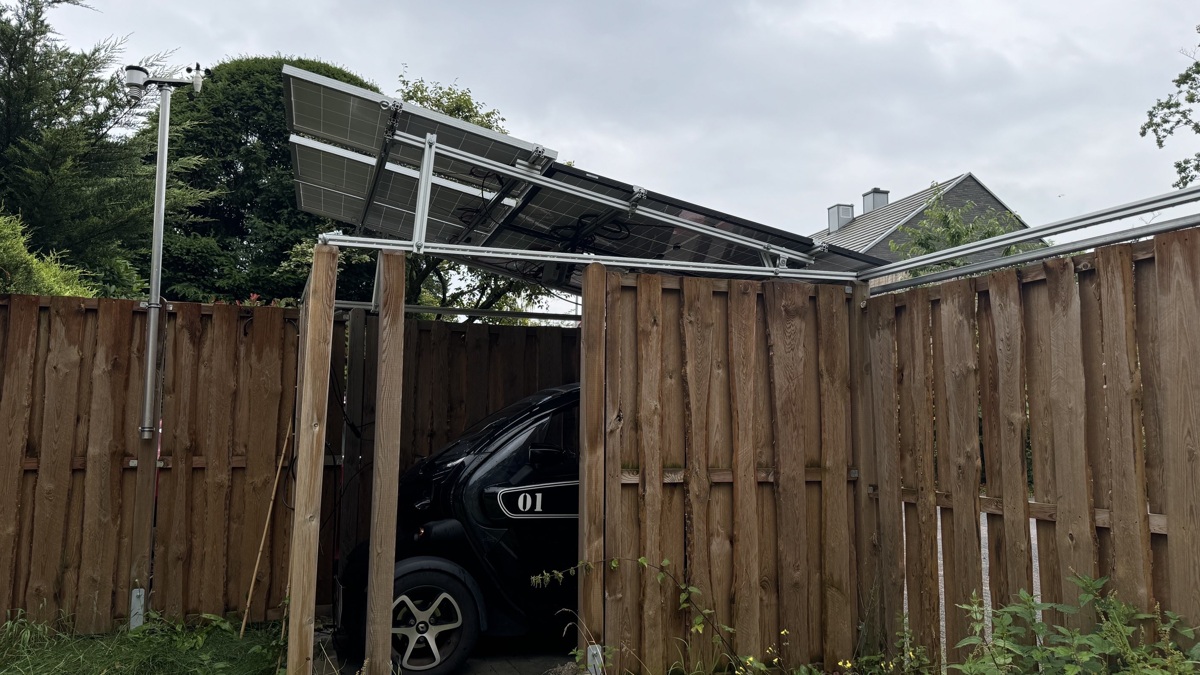 The 130 kWp panels are cabled serially but still seem to have issues getting enough voltage to start the inverter in the morning. 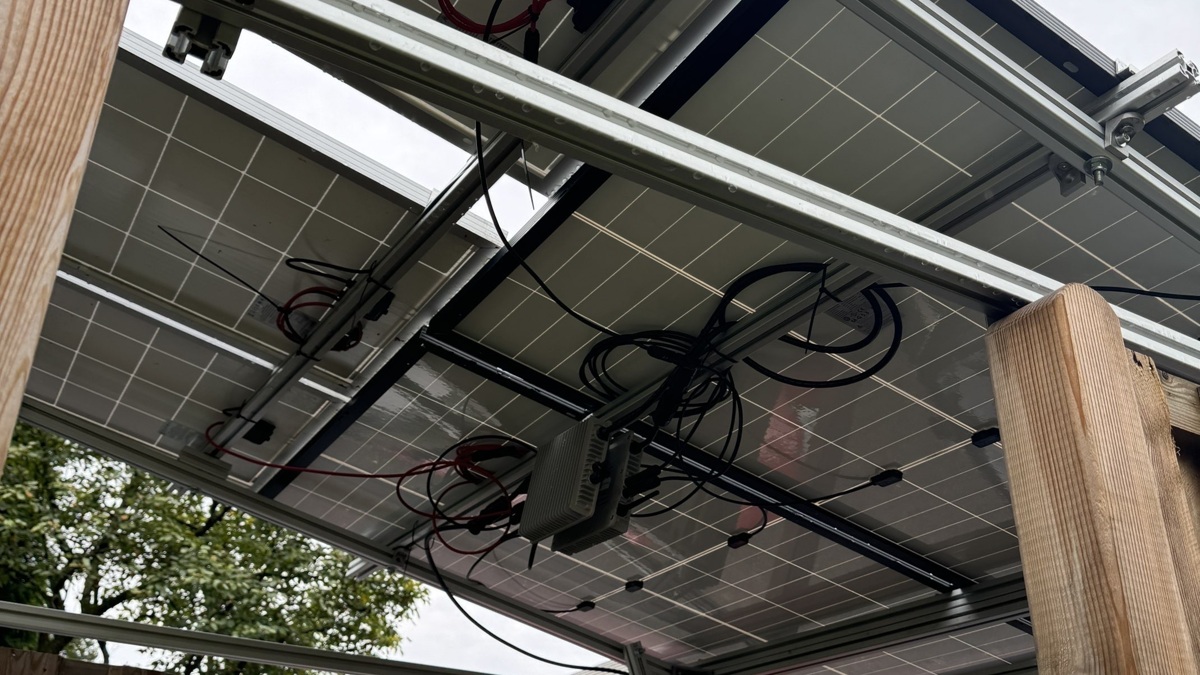 I’m happy with the project. Things in the shed are getting much less wet during rain und not baking hot during sunshine. I might close the gaps between the panels obe day but that is low priority- the thing was never meant to be totally watertight. I also like it being some kind of Solarpunk landmark in our street.
I'm looking for a small setup that allows the panel to be removed without removing screws from the roof and exposing holes.
My office/ lab at home uses around 600W when fully running, and I see that there are quite a few `power stations` that will comfortably handle that, and foldable 4 panel setups that can generate 300-400W. Would there be any issues plugging a UPS (my lab has a few of them) into a solar power station such as [this](https://us.ecoflow.com/products/delta-pro-portable-power-station?variant=40684178014281)? Is there some sort of feature I want to look for such as sin wave, etc to have this work reliably, or does a UPS not really care since the controller in the power station should be normalizing voltage, etc?
How do I design a large solar system that spans many buildings across a few km? If I search the internet for guides on how to design a photovoltaic solar system, the results are saturated with how to build a small setup (eg for a car or caravan) or a "large" setup (eg just for 1 building). But how do I get information on how to build an off-grid system that spans many buildings? What keywords can I even search-for that describe this type system to find such resources? The general specifications are: 1. A community of ~300 people, 1. Spanning ~10 buildings, 1. Each building is located 10-100 meters apart, and 1. Each building's roof has up-to 20 kW of PV panels The main questions that I'd like clarified revolve around how to tie the systems together. Should the batteries be stored in one building or distributed? Where should DC be converted to AC? If I end-up with >100 kW and want to [power heavy machinery](https://wiki.opensourceecology.org/wiki/CEB_Press), how many volts should the system be? What are the trade-offs in all of these decisions? Most importantly: what do you "call" these systems, and how can I find documentation and guides on how to build PV solar grids that span multiple buildings across a medium-sized community of tens of hectares.

Hey guys I am planning to do my own solar and am looking into some kits and prices. I was quoted $22k for a 7.4kw system but I'm thinking of doing a 12.7kw one myself without the bloat of a loan and contractor install. The problem I'm currently having is trying to pair up a premium panel with Enphase microinverter. I see that REC is highly regarded as one of the best, but the REC 420 is only compatible with the IQ8X which together will run me over 14k for just the panels and inverters, let alone the rest of the infrastructure. But the REC 400 is compatible with the IQ8A. Suntansolar has some pretty nice kits, one of which has the ZNshine 410's that run a little longer but I should have the space, as well as the Iq8a micros. But I'm not familiar with that brand. Does anyone have experience with a good combo set of panels and inverters? I think generally the consensus has been that microinverters are the way to go.
Can I connect a 5w 5w solar panel directly into a 10k mAh portable battery bank safely via USB 2.0, or does it need some sort of protection in-between like a solar charge controller or a schottky diode? Example of battery bank (except one with usb 2.0 input): https://www.anker.com/ca/products/a1229 Example of solar panel: https://www.aliexpress.com/item/1005006012344670.html 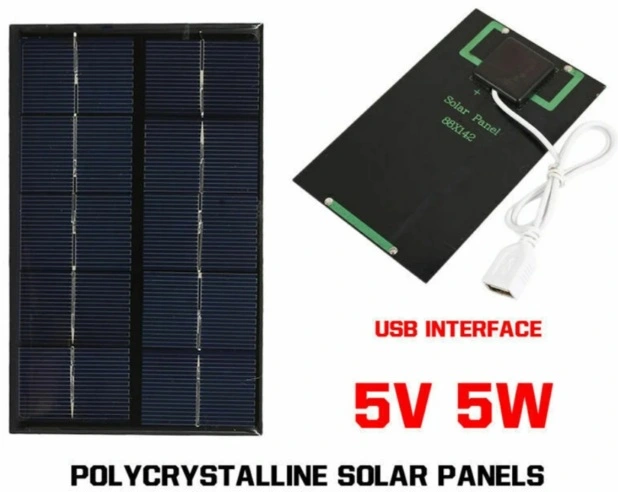
Hey all, I've got a set of three 60-cell panels and microinverters that I want to mount on an asphalt shingle roof. I'm planning to expand the array to 16 panels in time. Does anyone have recommendations for low-cost mounting systems and online retailers that sell them? I like the idea of rails, but from what I've seen shipping costs are prohibitive and I'm trying to do this on a budget, so rail-less options are appealing also.
For several years I've used a Raspberry Pi Zero for sensors, camera & door motor control which opens & closes a chicken coop door. The Rpi & controller is 5v, the motor is 12v. This has been powered by around 50' of extension cord, but the elements are beginning to weather the cord & we also need to move the chickens further away from our mains. I think it is time to implement solar. I aspire to assemble a PV, battery, & converter system which: - Uses an off-the-shelf 12v PV panel (30w or so) - Uses LiFePO cells for heat resiliency & stability - Provides both 12v & 5v power - Isn't proprietary; uses standard, easily-sourced components... unless it meets specs perfectly & isn't terribly expensive. - Minimal power draw; at most 2 amps @ 12v for 10 seconds twice daily. Does anyone have suggestions regarding this configuration, know of a post, blog, or video which does something similar, or is willing to ID components you'd recommend for this project?
The Renogy Wanderer states that it is optimized for 10A, 12V/24V batteries. What would happen if it was connected to a [battery pack](https://a.aliexpress.com/_mPcjOuo) containing one 3.6V 18650 battery such as [this](https://www.imrbatteries.com/samsung-35e-18650-3500mah-8a-battery/)?
 palmettoenergysolutions.us
palmettoenergysolutions.us
At Palmetto, as the go-to experts in renewable energy, we empathize with the unique needs of RV enthusiasts, particularly in regions like South Carolina, where landscapes transition from coastal retreats to lush woodlands. This blog post serves as your comprehensive guide to diverse solar panel options for RVs. We understand that informed decisions are crucial for your mobile adventures, and our goal is to equip you with the knowledge needed to choose the optimal solar solution. From high-efficiency monocrystalline panels to adaptable flexible options, Palmetto ensures that every RV owner finds a solar solution that perfectly aligns with their specific requirements and enhances their on-the-road experience. Palmetto's Commitment to RV Solar Solutions in South Carolina As the premier RV solar seller in South Carolina, Palmetto takes pride in offering a diverse range of solar panel options tailored to the unique demands of RV owners. South Carolina's diverse geography, ranging from coastal areas to inland forests, calls for versatile solar solutions that cater to the changing energy needs of mobile enthusiasts. Furthermore, Palmetto provides RV solar solutions designed to withstand diverse weather conditions, ensuring optimal performance in various terrains. Palmetto’s Overview On Different RV Solar Panel Options Palmetto's commitment to revolutionizing RV solar solutions is evident in our comprehensive overview of various options. Tailored to meet the distinct needs of RV enthusiasts, our solar panel range is designed to thrive in South Carolina's diverse landscapes. From high-efficiency monocrystalline panels to adaptable flexible solutions, each option in Palmetto's arsenal promises to elevate your RV experience. Join us as we delve into the intricacies of different RV solar panel options, empowering you to make an informed choice for an eco-friendly and enhanced journey. Source URL https://palmettoenergysolutions.us/our-blogs/f/exploring-different-solar-panel-options-for-rvs
Hi everyone, had anyone played with alternative battery technology to try and bring the cost of storage down when weight and space are not an issue? Zinc bromine? Nicole iron?
As my first foray into Solar DIY, I'd like to try to power a 5V computer fan with a solar panel. My goal is to run it for at least several hours per day. My understanding is that I'd need the solar panel (duh!), a fan, a charge controller, and a battery. As a newbie, I'd like to run my setup by this community since you know better than I do. Please let me know if this makes sense: Steps: 1. Strip end of solar panel wire and attach to charge controller 2. Connect micro USB cable to battery bank and strip the other end to connect to charge controller 3. Strip end of computer fan and attach to charge controller Parts: 1. 10W, 5V Solar Panel: https://web.archive.org/web/20231107180209/http://web.archive.org/screenshot/https://www.aliexpress.com/item/1005004587476483.html?spm=a2g0o.productlist.main.3.72bbaAk6aAk6KS&algo_pvid=4fe1d766-427c-4c24-978d-094fb385b2b9&algo_exp_id=4fe1d766-427c-4c24-978d-094fb385b2b9-1&pdp_npi=4%40dis!CAD!39.69!17.07!!!28.30!!%402101fb1116993792757332890e8301!12000029732119781!sea!CA!177099580!&curPageLogUid=tN1l84mY50ZP 2. Spare cable that terminates in micro USB 3. 10A Solar Charge Controller: https://web.archive.org/web/20231107180717/http://web.archive.org/screenshot/https://www.aliexpress.com/item/1005005210165491.html 4. 5000mAh, 5V 2A Input, 5V 2.1A output Battery Bank (one I have laying around similar to this): https://web.archive.org/web/20231107175655/http://web.archive.org/screenshot/https://www.aliexpress.com/item/4001322867876.html 5. DC 5V, 0.75W, 0.15A fan (also a part I have laying around)
Sorry if this is a wrong community to ask these question since my system is only partially DIY, but does anyone have experience with EPS systems like EcoFlow Delta? I'm trying to figure out exactly how it works when all 3 sources of power are available: battery, AC and solar. Is it able to use them in combination if solar doesn't provide 100% of demand? And if anyone is using UPS units, how are you dealing with lack of ground? I'm thinking of daisy chaining UPS to EPS to avoid sensitive equipment from shutting down during failover, but I'm concerned that UPS will not like operating without ground.
I’m starting to design a quite large solar pergola, to be built in the southern uk. Has anyone got any advice on the different methods of adding waterproofing between panels? And/or any general tips or experiences in constructing the pergola?
Has anyone here ever had success running either of these in a solar-powered off-grid structure? I've seen and read several sources/product reviews that advise against using each of these (especially incinerating toilets) with a solar setup, but I've heard anecdotes from a couple of people who used a dedicated solar panel for a mini-split and had no problem. I think an incinerating toilet is the best option for my location, but I'm not sure if I can swing it off-grid. (Cross posted in !off_grid)
I have three extra solar panels from a pack of 10 I ordered. I don't have room for them to fit with my other 7 panels and am looking for unique ideas on where to put them. I could throw them up on my east facing roof, or perhaps on a large playhouse in the back yard. I could lean them up against a south wall, or mount them to a railing. Any other crazy ideas?
I'm looking to build out a semi-off grid system for a cabin. I have a 2000w generator I'd like to use to feed the inverter/charger to assist with the battery charging. The datasheet indicates that it'll draw significantly more current than the generator can provide. Can the charge current be adjusted down in software? I see recommendations for buying a standalone AC charger, but that seems silly. I'm looking at the GroWatt SPF-3000 unit.
Will Prowse just posted a video on his DIY Solar Panel YouTube Chanel on installing a Mini-split HVAC system. He goes through the steps of installing one similar to one I installed in 2014. I paid around $678 for the unit with the intention of installing everything and then having a HVAC company charge the lines. I got busy and lazy and ended up hiring a company for $900 to do the install an setup. But had I known that you don't have to charge the lines, just pull a vacuum on them, I WOULD have made the time to install it myself! I will be installing a second unit in a year or so and was planning on going with Mr. Cool, but if there is still a large price difference, I will go with another Pioneer. So mine has been running for 9 years now, it peaks at 1,000 watts at start up and then pulls just over 500 watts when running.
What exists right now for someone who wants to make a *very* small solar project? A family member of mine was hoping to put 1 or 2 panels on the roof of their ADU to power maybe just the small window air conditioner in it, or at least offset a lot of its energy use. Is there anything practical for doing this that doesn't cost multiple thousands of dollars? In my imagined setup, there would be 1-2 panels on the roof connected to a cheap consumer battery (something like a small ecoflow). The appliance would try and run only off the battery, but if the battery charge level dipped to low it would have some controller that would switch it to grid power until the charge level was back up. I would not want to feed any power into the grid, but I wouldn't want the person living in the space to have to manually switch the power source between the battery and a regular outlet.
If your intention is to supply electricity back to the grid, it is advisable to consult your electric company and local permitting offices (such as city, county, or provincial authorities) to determine the necessary documentation. Requirements may vary, with some entities having stringent specifications for plan submissions, while others may simply prioritize the filing of an application. Even if a formal plan submission is not mandatory, it can be beneficial to create one for personal reference or potential future property sale, as it provides comprehensive information about the installation. It is important to include several key elements in your documentation. These should encompass a comprehensive list of parts and equipment, their respective power ratings, precise placement of all equipment, appropriate signage, circuit breaker amperage details, wire gauge specifications, conduit information and placement, accurate distances between components, precise equipment measurements, spacing measurements (including height from the ground), smoke alarms, fire breaks and wall backings, fire suppression systems, fire extinguishers, and clear call outs for power disconnects. Additionally, it is crucial to provide detailed documentation regarding disconnect procedures and shutdown protocols. The majority of these tools offer the capability to create precise drawings, plans, and sections of the solar installation. They enable you to incorporate labels, dimensions, and detailed electrical component information. Additionally, some tools provide shading analysis functionality to ensure optimal placement. Some have a steep learning curve, high price, or limited features. Since this is a DIY community I am mainly focusing on free options, but there are plenty of other commercial options not covered. - **Hand drawn sketches** - Never underestimate the ease of throwing together a plan on some graph paper! - **LibreOffice** (https://www.libreoffice.org) - A free office suite that includes several applications including Writer (word processing), Calc (spreadsheets), Impress (presentations), Draw (vector graphics and flowcharts), Base (databases), and Math (formula editing). Free. - **GIMP** (https://www.gimp.org) - GNU Image Manipulation Program - Is primarily an image editing program and does not offer specialized features specifically tailored for solar designs. However, it can still be useful for image manipulation and creating visual representations. One major feature is the ability to work in layers. While it may not have the advanced architectural-specific features found in dedicated CAD or architectural design software, GIMP is certainly a great tool to have. Free. - **Inkscape** (https://inkscape.org) - Used for technical illustrations such as diagramming and flow charting. It uses vector graphics to allow for sharp printouts and renderings at unlimited resolution. Free. - **FreeCAD** (https://www.freecad.org) - Provides a comprehensive set of tools including parametric modeling, sketching, part design, assembly design, and rendering. Has a high learning curve. Free. - **Open Solar** (https://app.opensolar.com) - Online solar design and proposal software. Offers multiple system options, fully rendered 3D designs. You can enter site address, paint on to-scale panels. Provides a pitch, azimuth and shading calculator. Free. Other tools you might consider, especially if you already have experience with them. - **Dia** Diagram Editor (http://dia-installer.de) - A software tool that offers several features for creating and editing diagrams. A better choice might be LibreOffice's Draw program. Free. - **Microsoft Office or other office suits** - Much like LibreOffice, there are a few other application suites to choose from that offer similar features as LibreOffice. - **LucidChart** (https://www.lucidchart.com) - Online tool that offers an intuitive interface and a library of shapes, icons, and templates that make it easy to create diagrams, flowcharts, wireframes, and other visual representations. Mainly designed for teams. Free limited tier available. - **SketchUp** (https://www.sketchup.com) - Browser based 3D modeling software. Free version available. - **BlueBeam** (https://www.bluebeam.com) - Used by Architects, engineers and builders, mainly designed for teams. No free version. - **AutoCAD** (https://www.autodesk.com) - Steep learning curve. Lots of features, mostly commercial offerings.
Currently the best hybrid inverter has got to be the EG4 18KPV Inverter with the Sol-Ark 15K coming in second only due to the $2,600 price difference. Both of these inverters can do it all. They are relatively easy to install, can be used with a small system and can scale up to handle a 200 amp system with as little as three units (you can start with one and two would cover most consumers needs), have small idle consumption, and can be setup in a variety of ways. If you are looking to DIY a system, I don't think you can go wrong with either of these units. - https://eg4electronics.com - https://www.sol-ark.com
Some people are terrified by electricity. I am guessing few in this community fall into that category. What makes you comfortable working with solar systems? For me, my father was an electrical engineer and I learned a lot from watching and helping him run new power and phone outlets. There wasn't anything he was scared of pulling apart to try and fix. I think the first outlet drops I installed in a wall were BNC coax drops in an apartment I was renting. I did take some computer architecture classes at university that formally introduced me to electricity and circuits, later I ended up taking some electrical courses, reading home improvement books, and lots of online videos. I guess I could also look back at the stereo installs I was involved in as a youth for myself and friends.
Are there any Din Rail Ampere Meters **that don't require AC power** to run? I currently have a shunt in my system that monitors the DC power coming in from my panels. I am about to upgrade my inverter to a smarter one and I will no longer need the shunt. But when looking around, I found some Din Rail ampere meters for AC and thought it would be nice to put something like that next to my DC circuit breaker near my panels. However, every one I have found appears to require AC power.
Here is my example for a starter system you can pick up to learn more about solar installations: - 2 to 4 [Renogy] 100-watt 12-volt solar panels - DC Circuit Breaker, 2 Pole 16 Amp Isolator ($16) - A [Y&H] 1000W DC30-45V Grid Tie Inverter (less than $150) - A MC4 Solar Crimping Tool with connectors ($25) - A Ferrule Crimping Tool Kit ($30) - Some MC4 Y Branch Parallel Adapter ($15) - Some appropriate sized wire. - Digital Clamp Multimeter - Optionally A Electricity Usage Monitor such as a [Kill-O-Watt] - Optionally a [Bayite] shunt/power meter to monitor your panels - Optional Rail Power Distribution Enclosure ($30) This isn't the most efficient system but it will give you enough of a challenge to start with, some tools you can use moving forward, allow you to begin generating power, and plenty of opportunities to ask questions. I put the usage meters as optional but really you should have something that allows you to monitor usage in real time. Run two of the solar panels in series (24 volts) and the two series in parallel (around 10 amps). From here you can add more panels, upgrade the inverter, experiment with mounting systems and angles, and finally (after an inverter upgrade) add batteries. Here are some useful links for calculating wire runs... -[http://assets.bluesea.com/files/resources/newsletter/images/DC_wire_selection_chartlg.jpg]() -[https://www.southwire.com/calculator-vdrop--]()

